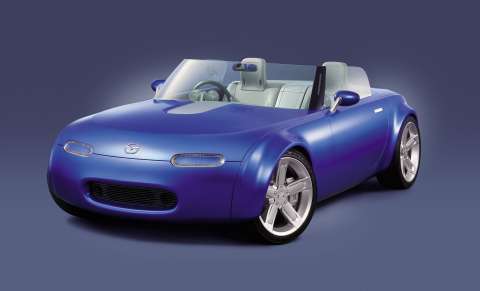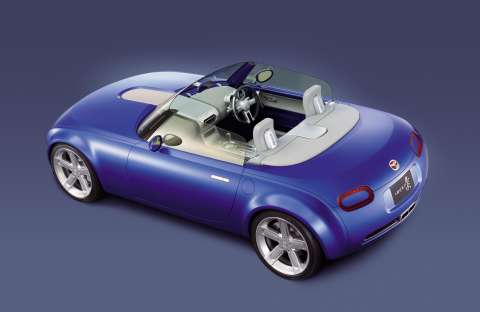 Mazda Ibuki at 2004 Australian International Motor Show |
 Mazda Ibuki at 2004 Australian International Motor Show |
 The Mazda Ibuki Concept Car is on display in Sydney, at the Motor Show. |
|
8th October, 2004
At its heart, Mazda has always been a company relentlessly pursuing a fun-to-drive spirit for all its cars. And no Mazda product better personifies this spirit than the MX-5: the small, lightweight, open-top, two seat sports car. Launched in 1989, the Mazda MX-5 re-established for enthusiasts around the world the concept of the lightweight open-top sports car and has gained an overwhelming amount of support from worldwide customers - the MX-5 is recognised in the Guinness Book of World Records as the best-selling, lightweight open-top two-seater sports car of all time. The Mazda Ibuki concept forms the centrepiece of Mazda’s stand at the Australian International Motor Show in Sydney. The concept clearly showcases Mazda’s current efforts in both design and technology as the development team works to further refine the company’s famous lightweight, open-top sports car. The Ibuki concept (the name comes from a Japanese word that refers to "breathing new energy into" and "adding vigor") reaches back to its 1989 origins as it hints towards one possible approach for a future MX-5 model. The overall aim with this concept was to further refine the fun-to-drive spirit that can be derived from a lightweight, open-top sports car. At the same time, the design team has worked to advance the true roadster identity and further refine the levels of comfort and safety in a vehicle with the top down. In an effort to more fully realise oneness between car and driver - a oneness that was the overall intent of the original MX-5 - the Ibuki design team has borrowed from the advanced front-midship engine layout of Mazda RX-8, although in this case employing an inline four-cylinder engine. Overall vehicle proportions have been defined by extremely short front and rear overhangs that confidently signify the extreme fun-to-drive spirit achieved by the innovative engine layout. The overall shape is clean and simple, reminiscent of the original Mazda MX-5, with a wide and stable stance, pronounced fenders and the elegant use of oval shapes throughout the design. Isao Tohda, a key member of the Ibuki development team who also played an important role in the development of Mazda RX-8 says: "We aimed for a sports car that offers the sort of fun felt from being in firm control of one’s own driving. With Mazda Ibuki, our primary theme was to minimise the car’s yaw inertia moment, and to take Mazda’s own sports car values to the absolute extreme. Mazda Ibuki is not simply a concept of what the future has in store. It is an ultimate statement of the kind of roadster Mazda could be building before very long." Essential to the success of Mazda Ibuki concept is the super front-midship layout that places all critical powertrain and accessory components within the wheelbase. The power unit, including the engine, radiator and key parts of the cooling system, is located towards the rear of the engine compartment, well behind the front axle. Compared to the current MX-5, the engine is located about 400 mm more rearward and 40 mm lower. To achieve this position, Mazda's design team moved the air conditioner unit behind the seats: an innovative idea that creates space within the dash section for part of the engine. At the back of the car, the rear-mounted air conditioner unit, fuel tank and main exhaust muffler are located ahead of the rear axle. The super front-midship layout allows substantial weight reduction in the front and rear overhangs, enabling a 15 per cent decrease in yaw inertia moment compared with Mazda's current MX-5. This decrease in the yaw inertia moment can be felt in the natural and linear handling, and superior control at the limit of tyre grip. The ultra low yaw inertia moment in itself promotes the kind of driving fun expected of a lightweight sports car. This layout also assures an adequate crushable zone, making a significant contribution to safety including the protection of pedestrians in accidents. For Mazda Ibuki, Mazda engineers developed a twin backbone body structure. Based on the high-mount backbone frame concept employed with Mazda RX-8, the structure comprises an open body frame with extensive reinforcements and a rigid lower backbone frame located beneath the transmission tunnel. This unique construction featuring upper and lower backbone frames helps the Ibuki concept achieve extremely high rigidity, a level of stiffness comparable to that of a closed body structure, while maintaining the extremely low weight demanded of a sports car. In addition to the lightweight, high-rigidity body structure, Mazda Ibuki employs lightweight materials at key strategic points. Reinforced plastic is used for the fenders, bonnet, rear floor panel and door outer panels. Brake discs and door inner panels are made of aluminium. The propeller shaft and power plant frame are of carbon fibre, while the wheels are magnesium alloy. This judicious use of lightweight materials keeps overall vehicle weight down. In addition to carefully choosing lightweight materials, the design team has also employed recyclable materials such as fibre reinforced plant-based plastic wherever possible. Mazda Ibuki has an overall length of 3640 mm. It measures 1720 mm in width, 1230mm in height and rides on a wheelbase of 2330 mm. The overall length is 315 mm shorter than that of the current MX-5. A key design feature is a 380-mm reduction in the combined front and rear overhang lengths, as compared to the current MX-5. With the exterior, Mazda capitalises on these compact dimensions and the benefits of the twin backbone frame to give concrete support to driving functions. The oval body shape evokes a look of tension in repose, and the 18-inch wheels and run-flat tyres accentuate the car’s well-planted stance. The body form also communicates the snug yet comfortable fit that both driver and passenger enjoy. Front and rear views inherit the familiar look of the first-generation MX-5 married to a more futuristic design. The radically curved windscreen conceals the front pillars and gives occupants of the Mazda Ibuki a wide field of view as well as a distinctive character. "Sports car design is a question of expressing the car's frame, and begins by supporting driving functions," said Moray Callum, general manager of Mazda Design Division. “With the Ibuki concept, we aimed to visualise, as simply as possible, the car's compact size and the undeniable excellence of its super front-midship layout. The results can be seen in a contemporary design that also manages to evoke the familiarity of past MX-5s. As we work to develop the future direction of the MX-5, it was very important for the Mazda design team to fully understand and appreciate the original. The purity of the original design is particularly interesting to us." The high-mount backbone frame presents an axis that integrates interior and exterior design. The interior expresses the strength inherent in the backbone structure that extends forward beyond the dashboard towards the bonnet and rearward to the cowl aft of the seats. This smooth continuity of interior and exterior is further emphasised in the smooth joining of the rear cowl and interior, and the way the passenger seat integrates with the body and creates a sense of unity between interior and exterior. Locating the air conditioning unit behind the seats confers two major advantages. First, it allows the engine to be mounted much further to the rear. Second, it helps enable improved independent left/right zoning so that occupants can obtain comfortably warm or cool air according to their individual needs, even when driving with the top down. Spot-cooling zones provide cool air for the neck, the back and the pelvis, and thighs, three areas of the body particularly sensitive to temperature change. Louvers are installed in the rear cowl section (for the neck), within the seatbacks (back and pelvis) and upper part of the centre console (thighs). For cold weather driving, a heating zone traps warm air between the occupants’ waist and lower extremities. Warm air is directed to the thighs from a louvre in the top of the centre console. In this way, occupants enjoy a comfortable cabin environment during open-top driving, irrespective of the season or weather. Mazda Ibuki is powered by a new, lightweight and compact 16-valve MZR 1.6-litre in-line four-cylinder engine equipped with sequential valve timing and lift for both intake and exhaust valves. The engine features an integrated electric hybrid motor that improves acceleration and partly serves to control engine vibration, allowing use of a lighter flywheel for heightened response. At low engine speeds, the electric hybrid motor provides torque assistance to boost acceleration from a standing start. Additionally, when the car is stationary, the hybrid motor automatically stops the engine from idling to save fuel and reduce emissions. The motor then restarts the engine automatically when the driver is ready to accelerate. Also, during deceleration the hybrid motor functions as a generator, using regenerative braking energy to recharge the battery. Mazda Ibuki features a six-speed manual transmission. The transmission weighs less than the current MX-5 gearbox and has reinforced synchronisers to give a decisive yet smooth shift feel - a hallmark of the original MX-5 - with extremely short, precise throws. In an effort to advance safety in open-top vehicles, the Ibuki design team has installed a four-point active roll bar into the front pillars and rear cowl section that instantly lifts up under impact sensor control to reduce occupants' injuries in the event of a rollover. Powerful LED headlamps give improved visibility, and a keyless entry by ID card is provided. Other innovations include a unique side-parting boot offering a wider opening and easier access. In addition, a new audio system that combines the seat air conditioner ducts and speaker in one, delivers much clearer sounds. This feature enhances the open-top driving.
| |||||||||||||||||||||||||||||||||||||||||||||||||||||||||||||||||||||||||||||||||||||||

